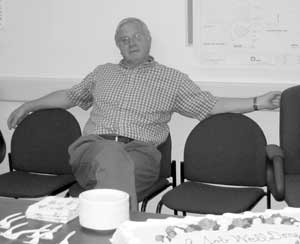 |
|
Mission: Luminosity by Steve Holmes
The sign says it all about our mission for this critical time in the Beams
Division and at Fermilab—we are focused on improving the performance
of the Tevatron for Run II, almost to the exclusion of anything else. Lots of
people have already told me how much they like it—an indication that people
in the division and in the laboratory are committed to succeeding.
I moved in as interim head
of the Beams Division, at
the request of Fermilab
Director Michael Witherell,
for the period between the
completion of John Marriner’s
term and the arrival of a new
division head. It is fun to be
back in Beams and working
directly with many friends,
old and new, in attacking
problems and meeting the
challenge of improving
Tevatron performance. I have
established a number of
intermediate-term goals
for the division for the period
of my stay: first and foremost among these is to achieve a luminosity of
4.0x1031 cm-2sec-1 (4E31 for short) accompanied by an integrated luminosity
of 7 pb-1/week by the end of September. This is a challenging goal, but
one that I believe is within reach. A secondary goal is to bring on board
the person who will take my place as the Beams Division Head by the end
of the year. We are making good progress and have every expectation of
being able to hand over the reins by the New Year.
The reaction of all the laboratory’s division
and sections to the current situation has been
extremely gratifying. All have offered help and are
pitching in to help us succeed. The Computing
Division has played a leading role in getting the
Shot Data Analysis (SDA) system up and running.
The Particle Physics Division is supplying people
to help on a variety of instrumentation projects
and even contributed their Deputy Division Head,
Stephen Pordes, who is now a member of the
Beams Division coordinating Run II instrumentation.
In addition to its usual indispensable support role
of magnet repair and refurbishing, the Technical
Division is helping us understand potential
problems with noise in the Tevatron RF system,
looking into monitoring systems for magnetic fields,
and taking the lead on a number of hardware
projects. And more assignments are in the works.
We are confident that all Fermilab staff members
stand ready to help when and if they’re called on.
In parallel we are starting to integrate help from
the outside world. SLAC, Berkeley, Brookhaven,
Argonne, and CERN are all either providing
support or are in the process of being taken
up on their offers of help. Again, the outpouring
of offers has been extremely gratifying.
Unfortunately, while these rigorous efforts are
moving forward, many long-term efforts including
R&D on linear colliders, muon facilities, and new
proton sources have gone onto the back burner.
This does not mean these activities are
unimportant—they are important, and we look
forward to bringing them back. However, it is
our belief that the single most important thing
we can do today to enable the construction of a
future forefront facility at Fermilab is to bring the
Tevatron up to its full potential now.
Success in meeting the goals established for
Run II will not be easy. It will require everyone’s
best efforts. I have been at Fermilab for 19 years
and am well acquainted with the capabilities of
the people who work at the laboratory and in the
Beams Division. There is no question that our
staff has the ability to take the Tevatron where
it needs to go.
On the Web:
|
 The sign went up on July 15, my first day back in the Beams Division.
The sign went up on July 15, my first day back in the Beams Division.
 We have made considerable progress on improving performance of the
Tevatron over the last several months, building on the efforts initiated under
John Marriner’s leadership. On July 26 we reached the highest luminosity in
the history of the Tevatron—2.64E31, eclipsing the previous best of 2.50E31
achieved on May 10, 1995. It is certainly gratifying no longer to have to refer
to our best stores as “21st century records.” But we still have a long way to
go. We’ve improved performance by more that a factor of two since January,
but we’re still about a factor of two behind where
we hoped to be at this time. A great deal of hard
work has already been invested in bringing the
Tevatron performance up to where it is today,
but it will take a continued and concerted effort
to get to where we and the high energy physics
community would like to see us operating.
We have made considerable progress on improving performance of the
Tevatron over the last several months, building on the efforts initiated under
John Marriner’s leadership. On July 26 we reached the highest luminosity in
the history of the Tevatron—2.64E31, eclipsing the previous best of 2.50E31
achieved on May 10, 1995. It is certainly gratifying no longer to have to refer
to our best stores as “21st century records.” But we still have a long way to
go. We’ve improved performance by more that a factor of two since January,
but we’re still about a factor of two behind where
we hoped to be at this time. A great deal of hard
work has already been invested in bringing the
Tevatron performance up to where it is today,
but it will take a continued and concerted effort
to get to where we and the high energy physics
community would like to see us operating.